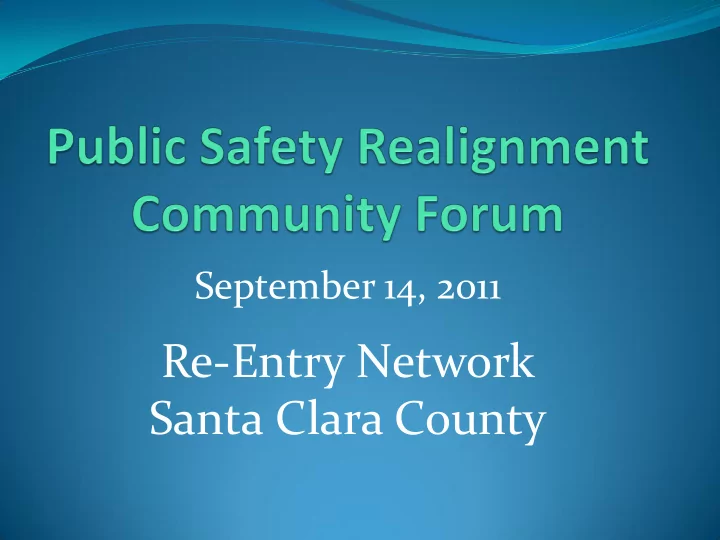

September 14, 2011 Re-Entry Network Santa Clara County
“ S u p p o r t , S e r v i c e s , a n d S u p e r v i s i o n f o r S u c c e s s ” VISION To build safer communities and strengthen families through successful reintegration and reentry of formerly incarcerated individuals back into Santa Clara County. MISSION To reduce recidivism by using evidence-based practices in implementing a seamless system of services, supports, and supervision.
Community Based Service Areas
Re-Entry Network Framework Juvenile State Justice System Realignment County Jail System
Why Realignment from State to County? Costs of State Prison System Growing Funds for Correctional Activities shrinking Several Class Action Suits Filed Against State of California Recidivism (re-offense) Rates at 70% Court Order to Reduce Prison Population
What are the Key Changes to Criminal Justice system? Redefining many felonies – local custody Local “post release community supervision” Parole Revocations to be heard by Courts Parole Revocation terms served in county jail
More Key Changes Changes to custody credits – day for day credits Contract authorization with CDCR Expands alternative custody for local commitments
Public Safety Re-Alignment AB 109/117 System of Care Community Custody Programming Offender Supervision Community
System of Care - Services Inter-Departmental Sponsors Group Re-Entry MAP (Multi-Agency Pilot) Full Health, Housing and Benefits and Service Mental Health, Residential Economic Partnerships Substance Use Supports Supports Services Employment Self-Help & Peer Faith, Family & Community & Education Supports Supports Support Service Partnerships
Who is going to stay local? Non-non-nons (N 3 ) without disqualifying offenses (current or prior) Non-violent felons Non-serious felons Non-sex offenders
Offender Post Release CJ Commitment Community Supervision (1170(h)PC) (CDCR estimates 1,000 (CDCR estimates 55 per month) releases by June 2012) Re-Entry Team Re-Entry Team (Probation/Health/Behavioral Health) (Probation/Sheriff/Health/ visits CDCR facility- meets with offender Behavioral Health) meets with to conduct assessment, reviews offender to conduct assessment conditions of release/hand delivers 60 days prior to release resource packet 60 days prior to release Re-Entry Team creates a Post Re-Entry Team creates a Release Case Plan for transition Post Release Case Plan for into community – Meets with transition into community offender within 48 hours of 30 days prior to release release to discuss case plan Referrals to resources- Referrals to resources - Re-Entry Team Re-Entry Team communicates with communicates with provider provider Case Plan- Case Plan- Supervision Supervision Re-assess needs Re-assess needs Adjust case plan Adjust case plan as needed as needed Graduated Graduated Supervision Supervision Programs Programs Sanctions Sanctions Voc/Med/ Voc/Med/ Family Family Outcome success or Outcome success or failure failure
State Realignment – Community Corrections Partnership State law established a Community Corrections Partnership in each county to serve as an advisory body for funding allocations Executive Committee: Chief Probation Officer – Chair Sheriff A Chief of Police District Attorney Public Defender Presiding Judge Director of Mental Health or DADS
Community Based Sanctions Intermediate sanctions may include: Flash incarceration of up to 10 days Intensive community supervision Home detention – EMP and GPS Mandatory community service Restorative justice programs Work, training and education furlough programs Work release programs Day reporting Mandatory substance abuse treatment Mandatory drug testing
Summary of Recommendations Support ongoing efforts to implement evidence based practices in the supervision and case management of all adult offenders in Santa Clara County with the goal of reducing recidivism. Continue to explore options to leverage community and treatment resources in order to provide effective evidence based programs to adult offenders. Support and strengthen relationships with local law enforcement agencies and task force teams to ensure public safety and offender accountability. Strategize to reduce racial and ethnic disparities at key decision points across the criminal justice system.
Measureable Goals Increase the use of community sanctions and programs for lower level felons, parole violators, and community supervision clients. Increase the connections and coordination between offenders and potentially helpful people and services in the community. Including family, educators, potential employers, and faith-based agencies.
More Goals Develop an efficient system that strengthens cross agency coordination and use of services. Increased outcomes as it pertains to housing, sobriety, and employment. Reduce offender recidivism rates. Reduce prison commitments from the counties, thus reducing the overall prison population. Reduce racial and ethnic disparities
Recommend
More recommend